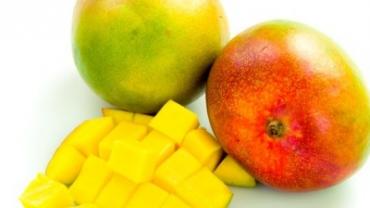
As we’ve mentioned in previous blogs due to the rising incidence of insulin resistance and metabolic syndrome we see that fruit has earned a not-so-great reputation among many. Whether it’s because of the total amount of natural sugar or the fructose content specifically many people are banishing fruit from their diets. Berries often get a free pass because of their anthocyanin content and low glycemic load. But thanks to the growing fear of fruit tropical fruits in particular—bananas papayas guavas—may as well come with skulls and crossbones on their supermarket stickers. But healthy populations have been consuming fruit for centuries so where’s the disconnect? Do mangoes belong in the same category as high fructose corn syrup and fructose-rich agave nectar?
Yes healthy tropical populations have been consuming mangoes throughout the ages. And of course they can fit into a nutrient-dense diet. Some individuals—particularly those with metabolic syndrome insulin resistance and type-2 diabetes—may be better off limiting their consumption of fruit but other people may actually benefit from a higher amount of carbohydrate in their diet especially when it comes from whole unprocessed fruit as opposed to refined grains. For example mangoes make a delicious addition to post-workout protein shakes for hard-charging athletes and bodybuilders.
Nutritionally speaking mangoes provide good amounts of vitamins C and B6 vitamin A (as beta-carotene) and copper. They are fairly high in carbohydrate—28g for a cup of sliced fruit (165g)—but thanks to a high water content and a small amount of fiber the glycemic load is low. The fructose component of mangoes may also contribute to their low glycemic load. 100g of mango contains 2.9 grams of fructose and 9.9 grams of sucrose which is 50% fructose. This may exceed the threshold some individuals are comfortable with—particularly those on low-carbohydrate diets—but overall compared to refined and concentrated sweeteners this is still a relatively low amount of fructose. If anything the difficulty of cutting around the large slippery seed of a mango without losing half the fruit in the process might be a bigger deterrent to consumption than the fructose! (Some varieties of mango such as the Ataulfo have a smaller seed so their flesh-to-seed ratio is higher.)
As is true for many other fruits the type of mango to be avoided is dried mango. Having had the water removed the sugars in dried fruits are more concentrated. Plus dried fruit is much easier to eat a large quantity of compared to whole fruits with their full amount of water. Dried fruit may also have extra sugar added as is common when dried fruit is included in granola and breakfast cereal.
The way mangoes are stored and processed may affect their nutrient and antioxidant content. For convenience many individuals choose to purchase pre-sliced or diced fresh or frozen mangoes. Preservation methods such as antioxidant treatment (with ascorbic acid citric acid and calcium chloride) and cold storage may help fruit retain its nutritional integrity but losses do still occur. Infrared heat treatment has been used as well and was shown to be effective for preserving the antioxidant capacity of fresh-cut mango cubes with minimal effect on the visual appearance of the fruit.
The popularity of mango juice in bottled drinks and smoothies has resulted in a buildup of waste products that are not consumed—the peels and pits. These may contain valuable compounds (such as oleic and stearic acids) that can be employed in the pharmaceutical nutraceutical and cosmetic industries and researchers are working on identifying the most efficient and effective extraction methods in order to preserve whatever bioactivity may be present.
For those who find that mango fits well into their diet mango salsa is a great topping for fish and a dairy-free mango lassi can be a great way to cool off in the summer heat. Mango also adds something special to chicken salad for a refreshing warm weather meal.